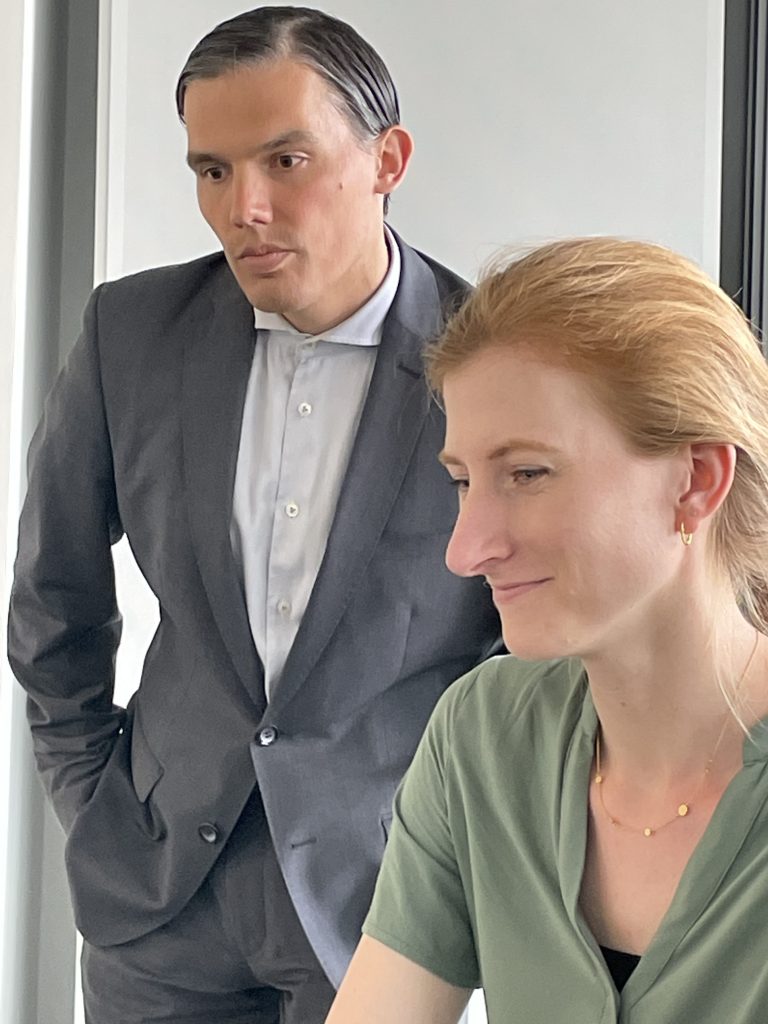HEUKING is one of the largest law firms in Germany, with more than 400 lawyers in eight major cities. Martin is the firm's co-head for the Public Sector and Public Procurement practice group. During his career, he has been involved in many landmark infrastructure projects in Germany. His Hamburg-based team of ten includes professionals specialised in Public Administrative Law, Contract Law, Procurement Law and State Aid Law. Critical time limits in government litigation sometimes bring the lawyers to their limits, and therefore, they have been searching for adequate tools and techniques to meet those requirements. Today, they have implemented an "agile working structure", which is now highly acclaimed for its effectiveness. Here is how it came about and what it means:
What was the working situation before the change was introduced?
Before we started the project back in 2017, we worked as follows: Lawyers had their own offices while assistants shared a larger room with two or three people. Research assistants and trainees were situated on separate floors. On all desks, there were file folders, signature folders, a telephone, pens and laptops. Lawyers used digital dictation devices, and the assistants had playback devices with foot pedals. Trainees typed their opinions themselves. Client work came in by phone, e-mail or sometimes still by postal mail. An assistant answered the phone call and transferred it to the respective partner. Upon listening to the case, the partner requested documents by e-mail and promised prompt action. Or the work came from the court. Then it arrived by postal mail and the result had to be sent back to the court the same way. Lawyers frequently travelled for business, sometimes attending client meetings multiple times a week, often by air. Assistants booked flights and managed travel expenses. Often, the clients also came to the firm. The assistants booked meeting rooms and arranged appointments with clients by phone. Otherwise, everyone worked in isolation all day long. Usually, all doors were closed. Interaction among department members was limited to brief updates and occasional chats in passing.
What was the catalyst or inspiration to undertake the agile working experience?
It began with digitalisation, which rendered most of the assistants' daily work obsolete. Typing briefs, answering phones, correcting and filing documents, booking flights – all traditional assistant work had become redundant within no time. Therefore, internal reorganisation was unavoidable. At the same time, we recognised an opportunity to organise our team more efficiently.
Are lawyers made for team play?
Lawyers traditionally are lone fighters even when working in large firms. They acquire clients and serve them with briefs and opinions or conduct negotiations to best assert their interests. On the other hand: Lawyers traditionally work in law firms and in Germany too, these firms have grown larger and larger. The clients have also grown: Large transactions and litigation with incredible amounts of documents have to be processed.
Do clients actually expect team play from their lawyers?
Yes of course, clients regularly speak in the plural of us lawyers. In case of a dispute, they assert, "You will hear from my lawyers". Indeed, size and headcount are also important selection criteria for clients when choosing a firm. And obviously, an army of lawyers promises more impact than just one professional. It is the same with doctors: When providing medical advice, it is often "my doctors said..." instead of referring just to one person.
How is that promise to be put into practice?
Looking for best practice, we drew inspiration from our IT clients. They already practiced "AGILE", they had Scrum masters, made SWOT analyses and decided according to design thinking processes. But they used it for programming apps and systems. We were curious to transfer this into our lawyers’ world.

Dr. Martin Schellenberg
How did you proceed?
First, we booked training sessions with IT Scrum masters and Kanban experts, and studied their project management methods. We pinned notes to pinboards and went through a process that we termed "team entanglement". Then we asked ourselves: How can we implement the promise that a team of lawyers actually provides added value for clients? In what ways can multiple individuals contribute to a case? How can digitalisation aid in streamlining this process? Armed with these questions, we began our journey.
An essential element of agile work in the IT industry, as we learned, is also the abandonment of classic hierarchies. The role within the team is no longer determined by seniority or status, but by the task. To implement this in our legal department, we first dispensed with selective coordination rounds for the professional groups involved. Scrum meetings are always conducted with all department members. They are led every month by a different member. This "acting editor” ensures that cross-cutting topics, such as the expansion of knowledge management, do not get lost in the daily business.
What else did you learn from IT-agile?
Indeed, agile promises more: With the agile approach, the production process should also become faster, more efficient and cheaper. Our legal "product" consists of briefs and opinions, among other things. How can we move away from the lone fighter mentality and towards real teamwork? Design thinking with the "Design thinking" relational table was one of the methods that was introduced to us in the coaching sessions. All aspects of a complex factual situation should appear before the mind's eye and be projected onto a graphical surface. This should make it clear to the team members what matters. We were also interested in how to ensure that all aspects of the factual situation are adequately considered and all legal issues are fully researched in complex litigation.
How can several team members work on the same case without producing patchwork?
After some experimenting with tools from the IT world, we realised that for us the happy medium lies in a very traditional legal method, namely the "relational table". During the traineeship, every German lawyer is introduced to the relational table and many keep using it when they later work in the judiciary or the legal profession. The facts and issues are prepared in a two-column table from the perspective of plaintiff and defendant and the solution is entered in a third column. The relational table becomes the basis for the design thinking process by placing it on SharePoint and giving all team members write access. If the case consists of numerous extensive files and many difficult legal issues, several participants can research in parallel and fill in the relational table. Since it is on SharePoint, all team members always see the entire content. Duplicate entries are immediately noticeable and can be corrected.
Against this background, the use of the relational table on SharePoint is not simply a departure from analogue work. SharePoint is rather the entry ticket for an integrative teamwork in the legal profession. Only with the "relational table" on SharePoint does it become possible for several lawyers to work on the same case at the same time. The threat to involve "my lawyers" instead of mandating a lone fighter finally receives its foundation. With the relational table on SharePoint, the team can quickly and effectively process extensive facts and legal findings into briefs. It is obvious that this can be of decisive importance for achieving success in litigation.

Can Agile help avoid mistakes in legal work?
It is of essential importance for the programming of an IT system that errors are detected quickly. "Fail fast" is the motto and this can also be relevant for legal work. Anyone with a few years of experience in the legal profession knows that sometimes you can get bogged down in a factual interpretation or legal opinion. If you have worked on a brief for several nights, you can easily become blind to certain facts. Only when you then hold the judgement in your hands do you realise what you have overlooked. Therefore, it is of course sensible if the pros and cons of an argument are discussed in the team. The SWOT analysis was invented for this discussion. Strengths, weaknesses, opportunities and threats are visualised in a magic square. Using the SWOT analysis, which is again filled in by several team members on SharePoint, a common litigation strategy can be developed and specifically checked for weaknesses.
How does this translate into daily practice?
Complex briefs and opinions have been created in this way for some time now using SharePoint relational tables and SWOT analysis. We first form a small team. Each team member receives a task in the research of facts and legal situation. Everyone feeds their result into SharePoint and then the team performs the SWOT analysis together. Finally, one team member takes over the consolidation of the text to create a work "from one piece".
Can you please give an example of how that works in practice?
Consider last year’s scenario when we were asked to represent various German states in litigation regarding a corona emergency procurement. Within a few days, we had to submit many extensive briefs with hundreds of pages of text to different chambers and courts. The facts differed in all essential points and concerned technically complex processes. The legal issues were also challenging. Without a system of structured cooperation in a larger team, we would not have been able to cope with this challenge.
What is AIs role in the agile organization
Artificial Intelligence helps us draft briefs, research facts and create presentations. As we work in an integrated team of lawyers, trainees and paralegals, AI helps us to standardise work with our knowledge management. Especially trained AI already today leads to fantastic results, constantly improving by working with additional cases. We certainly expect to improve profitability by integrating AI in our daily work.
How does the agile workstyle translate into office space?
Recently, we ventured into the experiment of making our physical work environment more flexible. We now draw lots for the workplaces every fortnight. Lawyers, trainees and project managers (we no longer have assistants) now sit mixed in two- or three-person offices. Anyone who has a longer phone call or video conference to conduct retreats to a designated "focus room". Remote work is also an option for those who find it more suitable. Especially for the trainees, the new office world is of course an improvement. They get a much more direct impression of the legal work and are more involved in interesting cases than before. The project managers also grow into legal work. Increasingly, they take on tasks that perhaps a lawyer would have done before.
Finally, what conclusions can be drawn from the experience?
Agile is fun. Teamwork is fun. The agile work structure gives self-efficacy to every team member. Providing self-efficacy to the team reduces absenteeism and frequent job changes. It therefore improves quality of work and finally leads to more client satisfaction.
Dr. Martin Schellenberg
Partner, HEUKING
Neuer Wall 63, 20354 Hamburg
Tel: +49 40 35 52 80 86
Email: m.schellenberg@heuking.de
www.heuking.de
Published by: www.lawyer-monthly.com

















